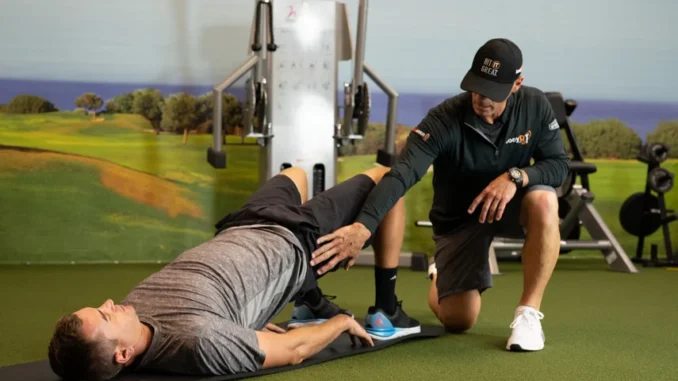
Golf may not seem like a physically demanding sport to some, but fitness plays a crucial role in improving performance on the course. In fact, a well-conditioned body can help golfers enhance their power, accuracy, flexibility, and endurance. By focusing on fitness, golfers can experience improved performance and reduce the risk of injury. This article will explore the importance of fitness in golf, the key areas of conditioning that help optimize performance, and how a fitness routine can benefit golfers of all levels.
Why Fitness Matters in Golf
Boosting Strength and Power
Golfers rely on strength to generate power in their swings, especially during long drives. Power is essential for maximizing distance off the tee and achieving better results on the course. Fitness training, particularly strength training, builds the muscle groups needed for a more explosive and powerful swing.
Improving Flexibility and Range of Motion
Flexibility is vital in golf for executing a full, fluid swing. A golfer’s ability to rotate through the swing, extend through the ball, and achieve a proper follow-through relies heavily on flexibility. Regular stretching and flexibility exercises enhance the range of motion, allowing golfers to perform at their peak and avoid injury.
Enhancing Endurance and Stamina
Golf is often a physically demanding sport, especially during long rounds and tournaments. Golfers need the stamina to maintain energy levels and focus throughout an entire round. A solid fitness routine helps build endurance, keeping players sharp and consistent from the first hole to the 18th.
Injury Prevention and Recovery
Golfers are prone to specific injuries, such as strains in the lower back, shoulders, and wrists, due to the repetitive nature of the sport. Fitness training can help reduce the risk of injury by improving posture, strengthening muscles, and increasing overall body stability. Additionally, conditioning helps with faster recovery times if an injury occurs.
Key Areas of Fitness for Golfers
Core Strength: The Foundation of Your Swing
A powerful and efficient golf swing starts with a strong core. The core muscles, including the abdominals, lower back, and obliques, are responsible for stabilizing the body during the swing. Strong core muscles enable golfers to maintain balance and control while generating power from the lower body.
Core exercises such as planks, Russian twists, and medicine ball throws can build the strength necessary for a more consistent and powerful swing.
Upper Body Strength: Generating Power
While the legs and core provide the foundation for a golf swing, upper body strength—specifically in the shoulders, arms, and chest—is crucial for generating power and maintaining control. Strong arms allow golfers to hit longer drives and achieve better distance control with irons.
Upper body exercises like push-ups, dumbbell presses, and rows help strengthen the muscles involved in the golf swing.
Lower Body Strength: Stability and Power
The legs and hips play an essential role in the golf swing, providing the power and stability necessary for a strong strike. A solid base of lower body strength allows golfers to drive through the ball while maintaining balance and posture.
Lower body exercises such as squats, lunges, and leg presses help develop the leg and hip muscles required for a powerful swing and stable stance.
Flexibility and Mobility: Smooth Movement
Flexibility is key to achieving a full range of motion during the golf swing. Limited flexibility in the hips, shoulders, and spine can hinder a golfer’s ability to execute a smooth, fluid swing. Mobility exercises are also important for improving the body’s ability to rotate and pivot effectively throughout the swing.
Flexibility exercises like yoga, dynamic stretching, and foam rolling can help improve the range of motion and prevent stiffness, ensuring golfers can move freely and efficiently.
Cardiovascular Fitness: Stamina for Long Rounds
Golf can be a physically demanding sport, especially during long rounds or tournaments. Maintaining cardiovascular fitness is crucial for sustaining energy and focus throughout the entire round. Good cardiovascular health also helps reduce fatigue and improves recovery time between holes.
Cardio exercises such as brisk walking, cycling, or swimming can improve stamina, ensuring that golfers remain sharp and energized throughout the day.
Benefits of a Golf-Specific Fitness Routine
Improved Swing Mechanics
A tailored fitness program focuses on building strength, flexibility, and mobility that directly enhance swing mechanics. By conditioning key muscle groups, golfers can develop a smoother, more efficient swing, leading to better ball contact, more accuracy, and increased distance.
Enhanced Mental Focus and Confidence
Physical fitness impacts mental focus and confidence. Golfers who are physically conditioned tend to have more endurance, better concentration, and a higher level of focus on the course. When you’re in peak physical shape, you can maintain your mental sharpness and confidence throughout the round, helping you stay in control even when the pressure is on.
Greater Consistency and Performance
A consistent golf game requires both physical and mental consistency. Fitness plays a significant role in achieving this consistency by enhancing physical capabilities like swing speed, flexibility, and endurance. With regular fitness training, golfers can maintain a high level of performance, even under challenging conditions.
Longer Career and Reduced Injury Risk
Conditioning reduces the risk of overuse injuries that golfers frequently face, such as tendonitis, muscle strains, or joint issues. A well-rounded fitness program not only improves performance but also ensures that golfers can enjoy the sport for many years to come by preventing injury and aiding recovery.
Creating a Golf-Focused Fitness Plan
1. Warm-Up and Stretching
Before any round or practice session, start with a dynamic warm-up and stretching routine. Focus on dynamic stretches for the hips, shoulders, and back to improve flexibility and prepare your body for the movement demands of the golf swing.
2. Strength and Resistance Training
Incorporate strength training exercises two to three times per week. Focus on core strength, upper body, and lower body exercises. Compound movements like squats, lunges, deadlifts, and chest presses are ideal for building strength.
3. Flexibility and Mobility Work
Dedicate time each week to flexibility exercises, such as yoga or dynamic stretching. Prioritize flexibility in the hips, shoulders, and spine to increase the range of motion and improve swing mechanics.
4. Cardiovascular Conditioning
Engage in regular cardiovascular exercises like brisk walking, cycling, or swimming. Aim for 30-45 minutes of moderate cardio at least three times a week to improve stamina and endurance.
5. Recovery and Injury Prevention
Incorporate recovery techniques such as foam rolling, stretching, and rest to help the muscles recover. This will reduce the risk of overuse injuries and ensure that your body stays in optimal condition for golf.
Conclusion: Unlock Your Full Potential on the Course
Fitness is a key component in every golfer’s performance. By enhancing strength, flexibility, and endurance, golfers can improve their swing mechanics, prevent injuries, and enjoy greater consistency on the course. Incorporating a fitness routine tailored to golf will not only boost your game but will help you play at your highest potential for years to come. Fitness isn’t just for elite athletes; it’s an essential part of every golfer’s routine. Get started today, and watch your game improve on every round!



Leave a Reply